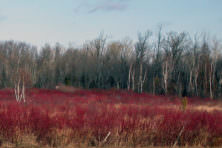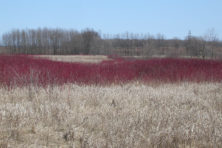Flowering Dogwood Trees
- Share
- Tweet
- Pin
- Share
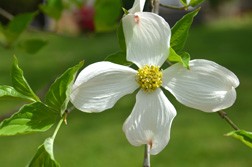
A dogwood tree flower shows its large showy white bracts.
Having recently returned from a brief vacation to the Blue Ridge Mountains to enjoy a welcome sneak preview of the “spring woods awakening,” we’re convinced there are few wild floral displays in the world that can surpass those of the Azaleas, Redbud and the Flowering Dogwood trees. Ask many old-timers from that scenic mountainous region what the most beautiful tree in the country is and very likely their reply will be, “the Flowering Dogwood.”
The last time we had seen these awesome small- to mid-size trees was in late April and early May of 1975 during our camping trip to the Great Smoky Mountain National Park. The thought of this 780-square-mile botanist’s paradise containing about 131 species of trees and 1,300 flowering plants, along with 1,800 fungi, greatly excited our imaginations.
Our recommendation is to visit this park from late April into early to mid-May before schools let out and the park becomes very crowded with family campers and vacationers. Bear in mind that this incredible park is the most heavily visited of all national parks in the U.S. The Flowering Dogwood trees begin blossoming there in late April.
Our recent North Carolina vacation took us to Blowing Rock in the mountainous northwestern part of the state which is generally to the east of the Smokies. However, it was only a matter of a half-hour’s drive that took us to a lower elevation where these greatly cherished and loved trees were at the peak of their blooming.
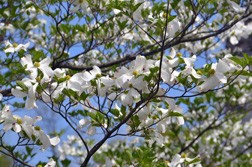
Flowering Dogwood trees are prized for their landscaping beauty.
The Flowering Dogwood tree, Cornus florida, originally evolved as a junior member of the eastern U.S. forests. There it thrives today under the canopy of larger trees in the shady, moist and nutritious conditions it prefers. It was the eastern U.S. forest region where many of the hardwood trees of the Upper Midwest originated.
This tree produces a downright spectacular spring floral display, has an attractive shape, luxuriant dark green leaves and is of moderate size. A large specimen is about 20 to 30 feet tall and has a crown spread about the same. The foliage turns a brilliant rich red in fall and the red fruits are very high in calcium, fat and other nutrients, attracting an unusually large number of animals, both mammals and birds.
Unfortunately this great tree has difficulty surviving the rigors of Wisconsin winters, although its hardiness range goes as far northward as Zone 5.
One of my favorite plant references is the three-volume Michigan Flora by Edward G. Voss. In it the Flowering Dogwood is found successfully growing in the southern half of the state, perhaps due in part to the prevailing westerlies that are somewhat warmed from the open waters of Lake Michigan.
In recent years there have been many successful cultivars developed of this popular tree, some of which are more tolerant of colder temperature. Use your computer to learn more about, for example, both the Stellar and the Jersey Series (both registered trademarks) of Dogwood trees developed at Rutgers University. These trees are also more disease- and injurious-insect repellent, have different colors, especially into the pinks and reds, and are considered good choices for landscaping. More attention is being aimed at developing smaller Dogwoods for smaller spaces. The Flowering Dogwood is the state tree of Missouri, but it is Tennessee, whose state tree is the Tulip Poplar, that takes pride in growing more Dogwood trees in its nurseries than any other state.
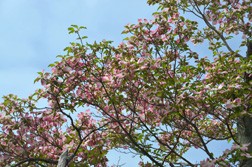
Here is the pink form of the Flowering Dogwood.
The bark of this tree is deeply ridged and always reminds me of alligator skin. I cherish a three-foot piece our friend, Dr. Chuck Miller, gave us when he and his wife Patsy lived in southern Indiana.
Another prized possession I have is a beautifully crafted honing (sharpening) stone box, complete with matching cover, a birthday present that Chuck made for me out of Flowering Dogwood. It is extremely hard and polishes well. For many years in the south, this wood was used to make weaving shuttles for textile mills – an interesting use for this wood.
“Huge” is the word to describe the blossoms of the Flowering Dogwood tree. Actually what most people assume are petals are in reality showy bracts (leaf-like growths) that are about two inches long and one and one-half inches wide. The true flowers are very tiny, perhaps as many as 30, have four very miniature petals, and are centered in the middle of the four, large, white showy bracts.
Even though we did see and enjoy mostly white Flowering Dogwood trees, both in the wild and on people’s home properties, we did thrill to the sight of quite a few pink specimens, all on privately landscaped property and never in the wild. The pink is listed as a form or variety under the scientific name of the more predominate white form, Cornus florida.
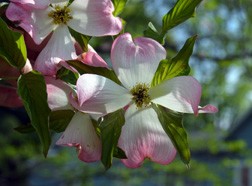
A close view shows the delicate pink on the bracts.
Our wildflower of the North, whose blossoms most closely resemble those of the Flowering Dogwood, is the small Canada Dogwood, Cornus canadensis, also known as the bunchberry when its striking red clusters of fruit ripen in late summer.
The Dogwood genus, Cornus, is small in America, consisting of only a dozen species. They range in size from the several-inch-tall Canada Dogwood to the Flowering Dogwood tree, occasionally attaining a height of 30 feet.
Cornus is from the Latin “corun,” a horn, in allusion to the hardness of the wood of the Dogwood tree. European butchers of years ago made skewers from the wood of the Common Dogwood, Cornus sanquinea (san-GWIN-e-a), of Europe and western Asia.
The tree was called skewerwood in parts of England and also “dagwood” from the Old English “dagge,” referring to a sharply pointed object. And so, there may be little connection after all between dogs and Dogwood, but what beautiful flowers the trees have!

